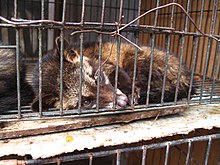Wildlife farming

Wildlife farming refers to the raising of traditionally undomesticated animals in an agricultural setting to produce: living animals for canned hunting and to be kept as pets; commodities such as food and traditional medicine; and materials like leather, fur and fiber.[1][2][3]
Purported benefits[edit]
Some conservationists argue, wildlife farming can protect endangered species from extinction by reducing the pressure on populations of wild animals which are often poached for food.[4] Others claim that it may be harmful for the majority of conservation efforts, except for a select few species.[3]
Certain African communities rely on bushmeat to obtain their daily amount of animal protein necessary to be healthy and survive.[5] Oftentimes, bushmeat is not handled with care causing the spread of diseases. Wildlife farming can reduce the spread of diseases by providing African communities with bushmeat that is properly processed.[4]
In his documentary film The End of Eden, South African filmmaker Rick Lomba, presented examples of the environmentally sustainable and indeed rejuvenating effect of certain types of wildlife farming.[6]
Associated risks[edit]
Wildlife farming has been linked to the emergence of zoonotic diseases, such as the SARs outbreak which has since been connected with the farming of civets.[7]
Current state of the industry[edit]
In recent years, South Africa has seen a massive growth in wildlife ranching (also known as game farming), which has led to a range of issues due to a lack of regulations.[8] This has led to the reclassification of 33 wild species as farm animals.[9]
As a result of the COVID-19 pandemic, approximately 20,000 wildlife farms have been shut-down in China. In the preceding years, the Chinese government had been promoting and incentivizing the development of the wildlife farming industry, which was valued as 520bn yuan, or £57bn, in 2017.[10]
See also[edit]
References[edit]
- ^ Damania, Richard; Bulte, Erwin H. (2007). "The economics of wildlife farming and endangered species conservation". Ecological Economics. 62 (3–4): 461–472. doi:10.1016/j.ecolecon.2006.07.007.
- ^ P, Chardonnet; B, des Clers; J, Fischer; R, Gerhold; F, Jori; F, Lamarque (Apr 2002). "The Value of Wildlife". Revue Scientifique et Technique (International Office of Epizootics). 21 (1): 15–51. PMID 11974626. Retrieved 2020-06-04.
- ^ a b Tensen, Laura (2016-04-01). "Under what circumstances can wildlife farming benefit species conservation?" (PDF). Global Ecology and Conservation. 6: 286–298. doi:10.1016/j.gecco.2016.03.007. ISSN 2351-9894.
- ^ a b Conniff, Richard (2016-08-30). "Wildlife Farming: Does It Help Or Hurt Threatened Species?". Yale E360. Retrieved 2020-06-04.
- ^ Ntiamoa-Baidu, Yaa (1997). "Chapter 2 - Direct contribution of wildlife to food security". www.fao.org. Retrieved 2019-03-06.
- ^ Lomba, Rick (1986). The End of Eden (film).
{{cite AV media}}: CS1 maint: date and year (link) - ^ Barth, Brian (2020-03-29). "Can Asia's infectious disease-producing wildlife trade be stopped?". Grist. Retrieved 2020-06-04.
- ^ Kamuti, Tariro (2019-11-14). "South Africa struggles to manage wildlife ranching: why it's a problem". The Conversation. Retrieved 2020-06-04.
- ^ Pinnock, Don (2019-10-15). "SA reclassifies 33 wild species as farm animals". Daily Maverick. Retrieved 2020-06-04.
- ^ Standaert, Michael (2020-02-25). "Coronavirus closures reveal vast scale of China's secretive wildlife farm industry". The Guardian. ISSN 0261-3077. Retrieved 2020-06-04.


 French
French Deutsch
Deutsch